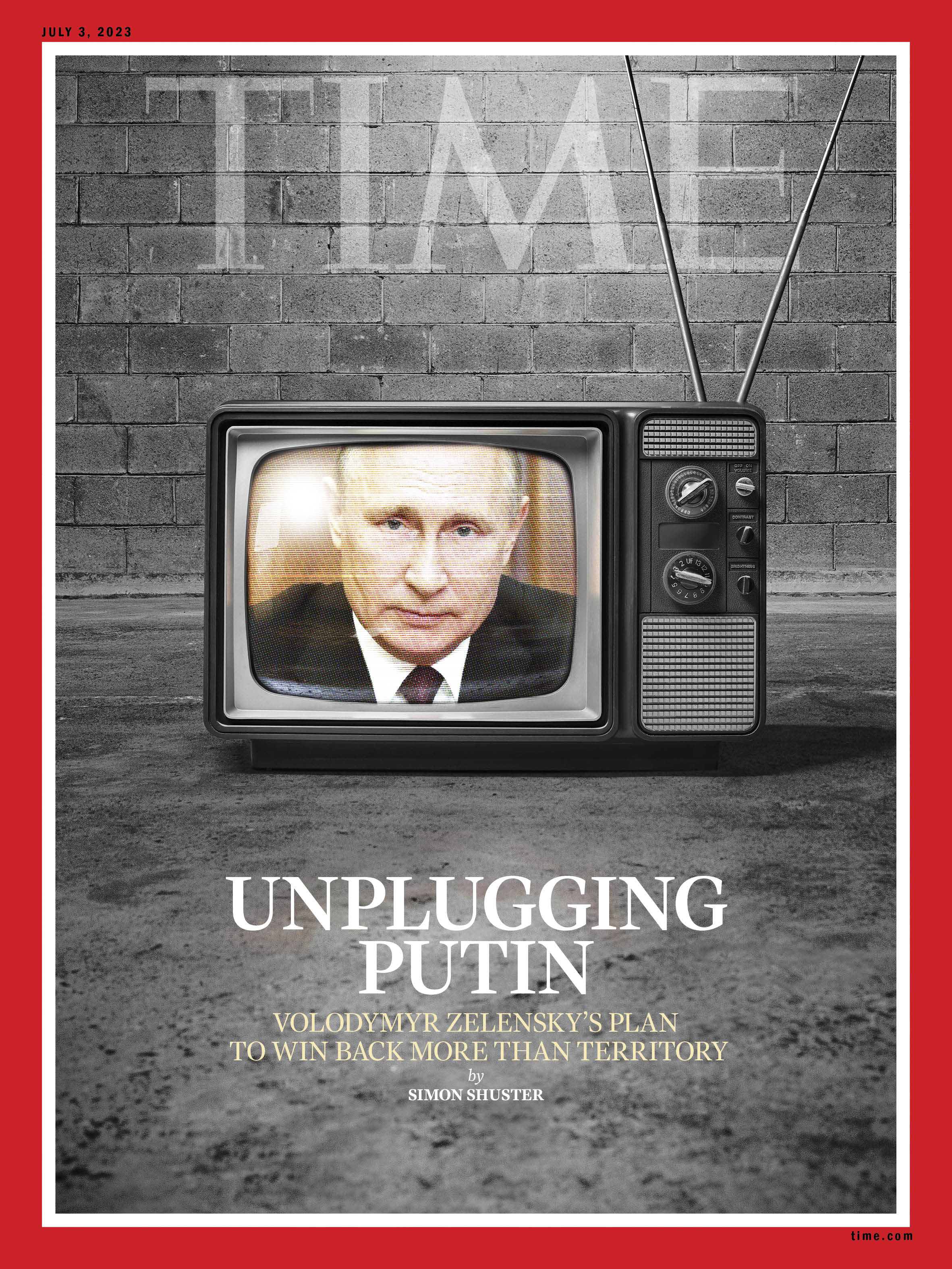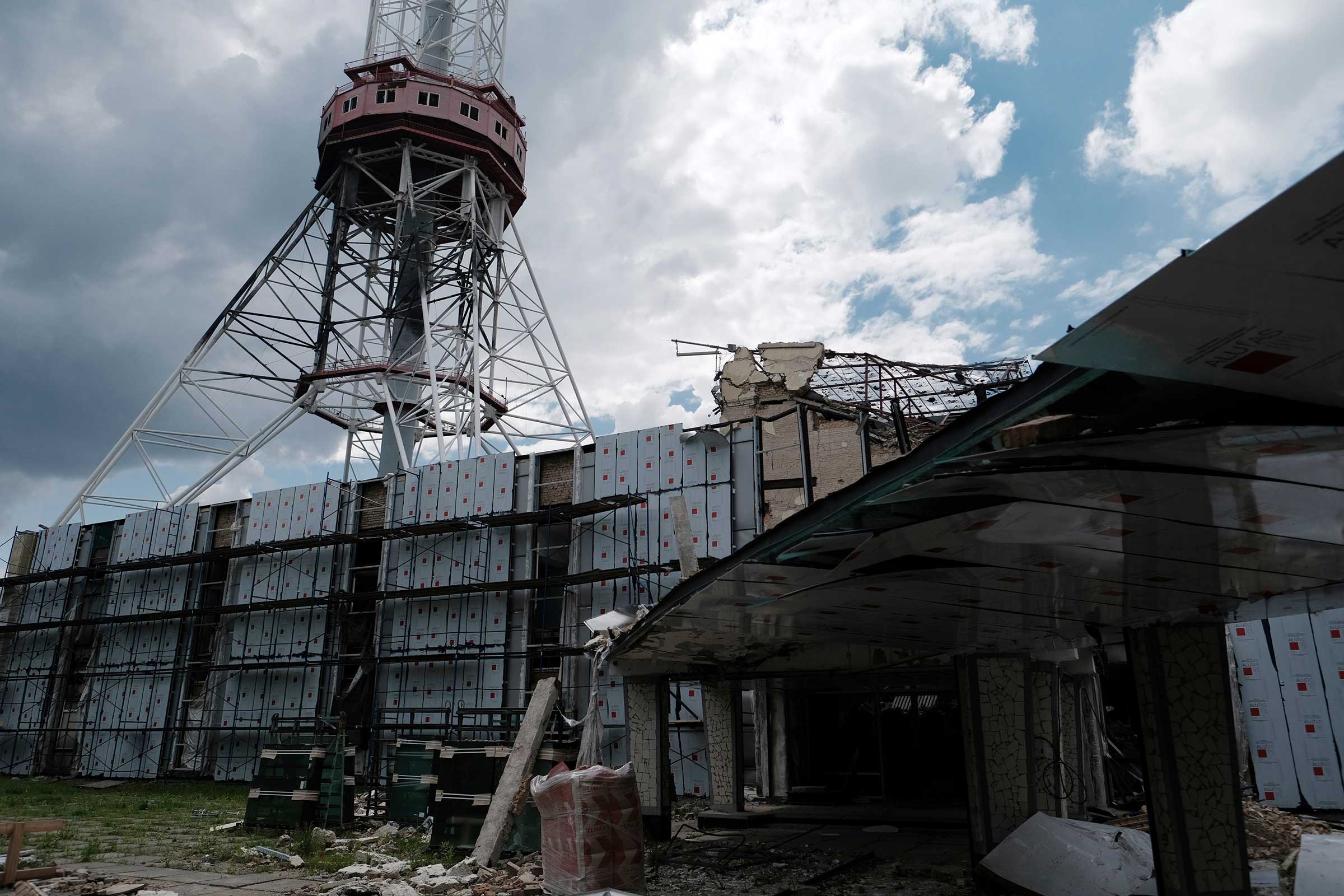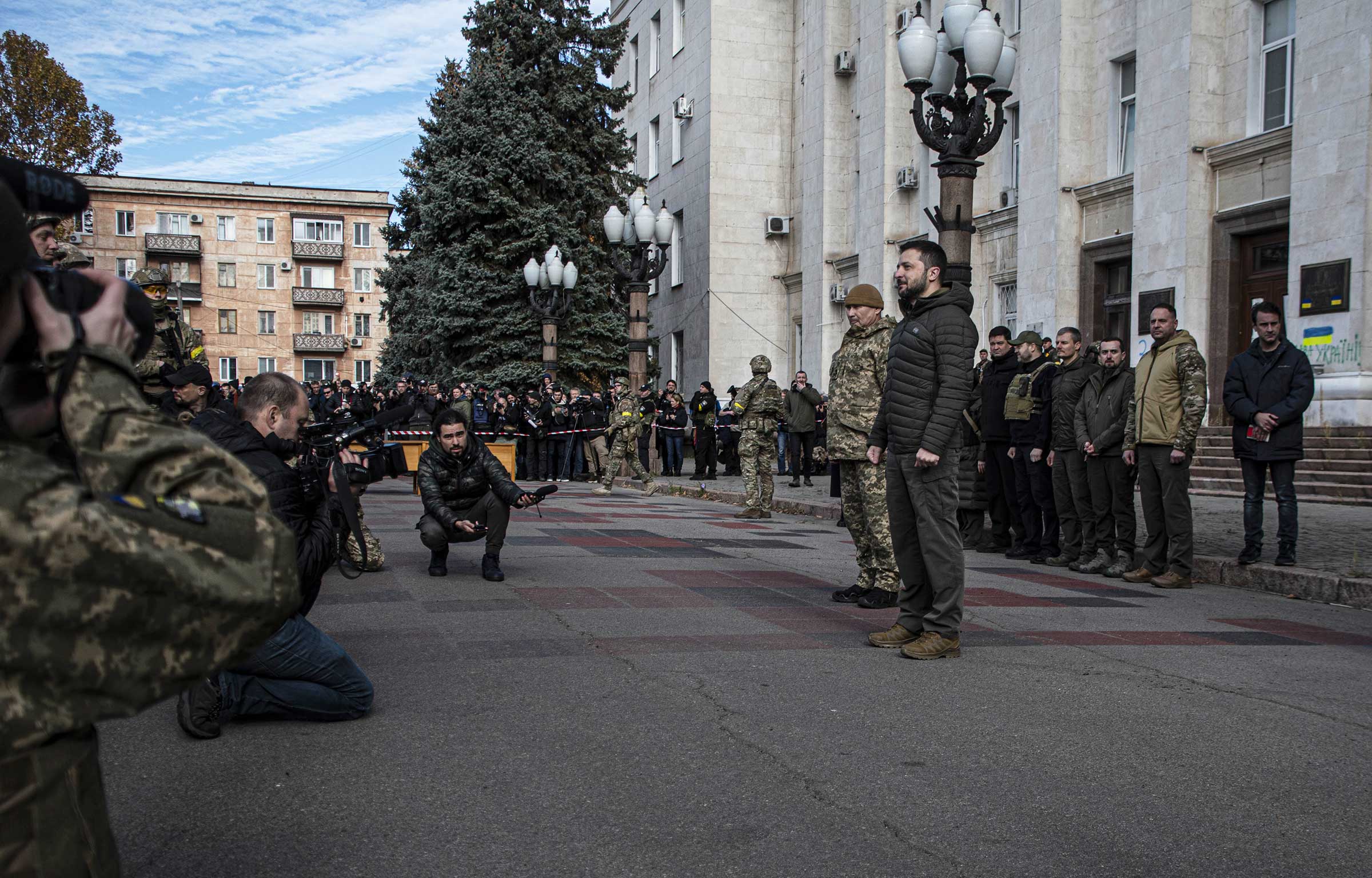
One day last fall, Volodymyr Zelensky, the President of Ukraine, came across a clip from Russian TV that had gone viral on social media. It showed one of Russia’s most prominent talk-show hosts calling for Ukrainian children to be killed—“thrown in a river with a strong current”—for speaking out against the Russian occupation of their homeland. Even by the ugly standards of Russian warmongering, the statement seemed to cross a line, and the host soon lost his job over it. But it continued to trouble Zelensky.
“Their society accepts this, consumes it,” he told me with evident disgust a few weeks later. “They live in this paradigm.” The Russian invasion of Ukraine was in its ninth month at that point, long enough to harden Zelensky to many of its horrors—the bombardment of Ukrainian cities, the kidnapping of Ukrainian children, the torture and killing of civilians—all of which the President addressed in our interviews with a defiant kind of stoicism. But the Kremlin’s propaganda, and the hold it seems to have over many of its viewers, still got under the President’s skin. “It shocks me,” he said, “the force of this information, the information sickness.”
Not only in Russia, but also across the occupied regions of eastern and southern Ukraine, millions of people absorb the Kremlin line about Ukraine through Russian television. Its central message, like a genocidal fever dream mixed in among gardening shows and soap operas, depicts Ukraine’s existence as a historical mistake, its government a cabal of satanists and neo-Nazis intent on Russia’s destruction. Zelensky, as the main villain in these narratives, does not believe their lack of subtlety makes them any less effective, and he has made it his mission not only to free Ukrainian land from Russian occupation but also to liberate Ukrainians from what he calls the “Russian information space.”

Since early June, when Ukraine began its biggest counteroffensive of the war, the armed forces have sought to prove their ability to shatter Russia’s defensive lines and regain territory. But Zelensky, who sees himself as more of a communicator than a military strategist, worries about the political challenges to come, especially the need to win trust and support among people living in occupied lands. To reach them, he plans to use the same weapon that Russia has used to indoctrinate them. “Ukraine needs to break through,” Zelensky told me, “with its channels of information as actively as possible.”
More from TIME
In regions occupied in early 2022, Russia has not been able to win much support. The residents of Kherson, in the south, showed mass resistance to the occupation, staging rallies and standing in the way of enemy tanks. “The Russians did not win in Kherson because, inside themselves, the people did not support Russia,” Zelensky said. “They held firm.” In other regions, the picture looks more complicated.
Crimea in the south and parts of the Donbas region in the east have been under Russian control for nine years, ever since Russian President Vladimir Putin first sent his forces to occupy them. With enough weapons from the West, Zelensky believes the military can evict the Russians from these regions. But he is far less certain about what comes next. “People in the Donbas, they’ve been brainwashed,” he told me. “All they have, every single day, is the Russian information space. Nothing else exists there. So there is no hope the people there see Russia as the real occupier,” he said. “I can’t reach them.”
Read More: Inside the Kremlin’s Year of Ukraine Propaganda
He still intends to try, even if his struggle with Russia in the field of propaganda comes with serious risks, threatening to undermine the very freedoms that Ukraine is fighting to defend. Zelensky has already faced criticism over wartime censorship, and the government’s plans to reintegrate Crimea and parts of the Donbas include tough methods, among them the forced expulsion of Russian civilians and what one Ukrainian general calls “carrots and sticks.” The President, a former producer and star of Ukrainian sitcoms, sees television as his weapon of choice for winning over people in the occupied territories. “I need to be able to speak with them all the time,” he says, “assuming they are still ready to listen.”
The battle for the airwaves has played out in Ukraine for nearly a decade, always in parallel to the clashes at the front. In eastern Ukraine, one of Russia’s first conquests took place on April 17, 2014, when a group of heavily armed militants drove up to a TV tower on Karachun Hill. At the gates, they encountered two guards, a man and an elderly woman, along with a shaggy mutt named Bim that looked too small for its doghouse. When I interviewed the guards a few days later, they told me the gunmen went straight up to the tower’s control room and asked the engineer to broadcast the frequency of Russia’s main propaganda channel, Rossiya.
The engineer complied just in time to show Putin’s annual call-in show, which lasted around four hours that day. Seated at a desk in front of a studio audience in Moscow, Putin used the show to expound on his imperialist vision for Ukraine. He referred to eastern and southern Ukraine as Novorossiya, or New Russia, and he argued that with the fall of the Soviet Union in 1991, these lands unfairly ended up outside of Moscow’s control—“God only knows why.” From that point forward, Putin would use all means at his disposal, including military power, he said, to protect the ethnic Russians living in these regions from their own government, which he described as a bunch of radical nationalists.

Coming a month after the Russian annexation of Crimea, Putin’s performance served as a warning that he could do the same with other regions of Ukraine. The government in Kyiv, which had come to power in a revolution that winter, understood that Putin intended to use his TV networks to stir a separatist rebellion among ethnic Russians, and it tried to block access to these networks across the country. Throughout May 2014, the Ukrainian military fought fierce battles for Karachun Hill that ended only after its TV tower was destroyed.
It made little difference. By the middle of summer, Russian forces took control of two major cities in eastern Ukraine, Donetsk and Luhansk, along with their television towers. “Let the people hear the truth,” one of the separatist broadcast engineers, Pavel Mikhalev, told me as he configured the tower in Donetsk to show Russian -propaganda that July. “Let them understand that Ukraine has no future as a state.”

When Zelensky took office in 2019, he believed he could win support across eastern Ukraine, even in the regions that had been under Russian control for around five years by then. The cities of Donetsk and Luhansk had turned into separatist enclaves, ruled by a cast of Russian-backed warlords and spin doctors who were often assassinated and replaced with new appointees of the Kremlin. One separatist commander, known as Batman, was sprayed with bullets on a roadside in Luhansk. Another was blown up in a café. A third, nicknamed Motorola, was bombed in an apartment building. A fourth was incinerated with a flamethrower. The list went on.
While Crimea survived on Russian tourism to its beaches, neither of the two separatist regions in eastern Ukraine had a functioning economy. International sanctions cut them off from any form of legal commerce with the world. Their leaders dealt in contraband, particularly the smuggling of weapons and coal, with some meager subsidies from Russia. No country in the world, not even Russia, recognized their independence. Yet they were home to well over 3 million people. Reliable surveys of public opinion were hard to come by in these regions. The best polling available suggested that in the fall of 2019, just over half of the people in the separatist parts of eastern Ukraine were not, in fact, separatists at all—they wanted to reintegrate with the rest of the country. Zelensky encouraged them.
A native Russian speaker, he had spent most of his early career as a comedian touring stages and concert halls across Russia and Ukraine. Many people in Crimea and the Donbas grew up watching his movies and TV shows. As President, Zelensky promised to start paying pensions to people living under Russian occupation. Soon new roads opened across the front line, making it easier for people in these regions to visit friends and family in other parts of Ukraine. “People should cross over and see that it’s better here, and slowly their opinions will change,” Zelensky said. “We need to bring them back and fight for them.”
Read More: Has Ukraine’s Long-Awaited Counteroffensive Begun? Here’s What We Know
But within a year of taking office, the President realized his message could not penetrate Russia’s monopoly on information in these regions. All major television networks in Ukraine were controlled by private media tycoons. Nearly all of them opposed Zelensky’s government, and a few were allied with the Kremlin. In early 2021, Zelensky banned three of the channels that he accused of broadcasting Russian propaganda in Ukraine. The move infuriated Putin, and European leaders criticized Zelensky for encroaching on the freedom of speech. But he saw no other way to curtail Russia’s influence over his citizens. “I think these channels killed a lot of people,” he told me after banning them. “Not directly,” he said, “but through information.”

In February 2022, with the start of the full-scale Russian invasion, Zelensky imposed martial law nationwide, which gave the state a powerful weapon in the information war. The airwaves in wartime are treated as critical infrastructure, and the authorities in Ukraine have the right to use them for national defense. Ukraine’s biggest television networks quickly agreed to set aside their political agendas and show a unified message of resistance, falling in line behind Zelensky.
The result became known as the Telemarathon, a round-the-clock broadcast of news and commentary that airs on all the major channels in Ukraine. Along with the latest updates on the fighting and essential advice on where to shelter, when to evacuate, and how to survive, the marathon carries Zelensky’s message into every household in the land. Nothing like it has existed in Ukraine since the Soviet era, and critics have complained that it smacks of propaganda. A strict new media law, which came into force in March, also earned Zelensky criticism for expanding the state’s ability to shut down news outlets. But he insists such measures are essential. “The weapon of information is very important,” he said last summer. “It’s also important to point this weapon not at one’s own head, but in the direction of the enemy.”
For nearly a year, as Ukraine’s armed forces have advanced in a series of counter-offensives, engineers have rushed to bring the Telemarathon to liberated towns and cities. The Russians have tried to block it. When they retreated from Kherson in November, Russian forces blew up the city’s television tower, which fell in a heap of metal beams and antennas over a city park. The Ukrainians used a transmitter donated by Poland to restore the TV signal in Kherson. Two days later, the Telemarathon showed Zelensky returning the national flag to the center of the city, where hundreds of people had gathered to celebrate their liberation.

In other parts of Ukraine, that kind of welcome would be hard to imagine. After living for nine years on the Russian side of the front, many people in Crimea and the Donbas may not accept Ukraine as their home. The youngest among them have grown up under Russian control, watching the Kremlin’s television channels. Thousands of young men in the separatist regions have been conscripted to fight against Ukraine. “They are also dying,” Zelensky says. “And when their bodies come home, they are told, ‘Look what the Ukrainians have done!’” As Ukraine retakes these regions, village by village and town by town, “we need to be ready,” Zelensky says, “for the fact that some of those people will not be happy to see us.”
Since last fall, when the military began advancing into Russian-occupied areas, the government in Kyiv has developed plans for reintegrating the people living there. Iryna Vereshchuk, who heads the ministry in charge of this process, says the government has begun to train teams of civil servants, teachers and social workers who can sweep into these regions after they are liberated and, as she put it in a recent interview with El Pais, remake the state “from scratch.”
The government expects many Ukrainians to move into liberated regions and help rebuild them once the Russians are expelled. Under Ukrainian law, anyone who collaborated with the occupiers must face prosecution in a period of “transitional justice,” which could take years. Ukraine estimates that over 600,000 Russians moved into Crimea in the years after its occupation. All of them will need to leave “voluntarily or through forced expulsion,” Anatoly Stelmakh, the deputy minister for the reintegration of occupied territories, told a Ukrainian news outlet.
Some officials in Kyiv have suggested harsher methods to root out Russian sympathizers. In a TV interview this spring, Kyrylo Budanov, the chief of the military intelligence service, said the influence of Russian propaganda has “modified the psyches” of people in occupied Crimea and eastern Ukraine. “We have to re-educate those who can still be re-educated,” he said. “With the carrot and the stick.”
Zelensky tends to take a softer line, insisting he can convince people in the occupied regions without the use of force or coercion. The ones who abetted the occupiers must face justice, he says, and under the laws against collaboration Zelensky signed last year, the penalties are stiff—up to 15 years in prison for the worst offenders. As for the rest of the people in these regions, Zelensky wants a chance to speak to them, if not in person then through television, and to change their minds. “We have to try,” he told me. “We have to get closer, and the closer we get to Donetsk and Luhansk, the higher the chance they might hear us.”
More Must-Reads From TIME
- The 100 Most Influential People of 2024
- Coco Gauff Is Playing for Herself Now
- Scenes From Pro-Palestinian Encampments Across U.S. Universities
- 6 Compliments That Land Every Time
- If You're Dating Right Now , You're Brave: Column
- The AI That Could Heal a Divided Internet
- Fallout Is a Brilliant Model for the Future of Video Game Adaptations
- Want Weekly Recs on What to Watch, Read, and More? Sign Up for Worth Your Time
Contact us at letters@time.com